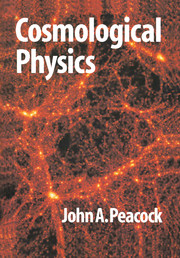Book contents
- Frontmatter
- Contents
- Preface
- Part 1 Gravitation and relativity
- Part 2 Classical cosmology
- Part 3 Basics of quantum fields
- Part 4 The early universe
- Part 5 Observational cosmology
- Part 6 Galaxy formation and clustering
- 15 Dynamics of structure formation
- 16 Cosmological density fields
- 17 Galaxy formation
- 18 Cosmic background fluctuations
- Hints for solution of the problems
- Bibliography and references
- Useful numbers and formulae
- Index
18 - Cosmic background fluctuations
Published online by Cambridge University Press: 05 June 2012
- Frontmatter
- Contents
- Preface
- Part 1 Gravitation and relativity
- Part 2 Classical cosmology
- Part 3 Basics of quantum fields
- Part 4 The early universe
- Part 5 Observational cosmology
- Part 6 Galaxy formation and clustering
- 15 Dynamics of structure formation
- 16 Cosmological density fields
- 17 Galaxy formation
- 18 Cosmic background fluctuations
- Hints for solution of the problems
- Bibliography and references
- Useful numbers and formulae
- Index
Summary
Mechanisms for primary fluctuations
At the last-scattering redshift (z ≃ 1000), gravitational instability theory says that fractional density perturbations δ ≳ 10−3 must have existed in order for galaxies and clusters to have formed by the present. A long-standing challenge in cosmology has been to detect the corresponding fluctuations in brightness temperature of the cosmic microwave background (CMB) radiation, and it took over 25 years of ever more stringent upper limits before the first detections were obtained, in 1992. The study of CMB fluctuations has subsequently blossomed into a critical tool for pinning down cosmological models.
This can be a difficult subject; the treatment given here is intended to be the simplest possible. For technical details see e.g. Bond (1997), Efstathiou (1990), Hu & Sugiyama (1995), Seljak & Zaldarriaga (1996); for a more general overview, see White, Scott & Silk (1994) or Partridge (1995). The exact calculation of CMB anisotropies is complicated because of the increasing photon mean free path at recombination: a fluid treatment is no longer fully adequate. For full accuracy, the Boltzmann equation must be solved to follow the evolution of the photon distribution function. A convenient means for achieving this is provided by the public domain CMBFAST code (Seljak & Zaldarriaga 1996). Fortunately, these exact results can usually be understood via a more intuitive treatment, which is quantitatively correct on large and intermediate scales.
- Type
- Chapter
- Information
- Cosmological Physics , pp. 587 - 612Publisher: Cambridge University PressPrint publication year: 1998



